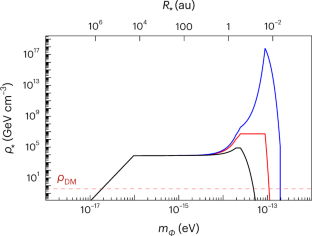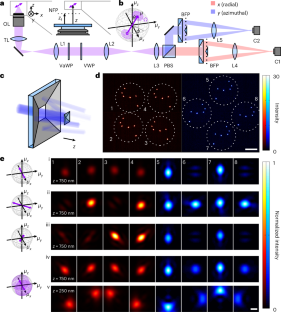- 宇宙の質量の大部分を占めるかもしれない、失われた重力の接着剤の探索。
Searching for the missing gravitational glue that may account for most of the cosmos’s mass.
- 光ハロスコープの超伝導ナノワイヤー検出器で暗黒光子ダークマターの新たな制約を発見 New Constraints on Dark Photon Dark Matter with Superconducting Nanowire Detectors in an Optical Haloscope
- 超伝導ナノワイヤーから暗黒物質への新たな制約を発見 New constraints on dark matter from superconducting nanowires
- 粒子検出器としてのトラップされた電子とイオン Trapped Electrons and Ions as Particle Detectors
- 宇宙量子センサーによる太陽に結合した超軽量暗黒物質の直接検出 Direct detection of ultralight dark matter bound to the Sun with space quantum sensors
宇宙の質量の大部分を占めるかもしれない、失われた重力の接着剤の探索。 Searching for the missing gravitational glue that may account for most of the cosmos’s mass.
2022-12-08 米国国立標準技術研究所(NIST)
超伝導ナノワイヤー単一光子検出器(SNSPD)は、光子(光の粒子)や暗黒物質粒子が検出器に衝突したときに与えられる極めて小さなエネルギーに、絶妙な感度を示すもので、このようなワイヤーを用いたシステムは、正式には「超伝導ナノワイヤー単一光子検出器(SNSPDs)」として知られている。
研究者たちは、ナノワイヤーが超伝導になるために必要な閾値のすぐ下の温度で、SNSPDを動作させる。そうすれば、粒子によってもたらされるわずかなエネルギーでも、ナノワイヤーに電気抵抗を発生させるのに十分な熱を発生させることができる。ナノワイヤーを通る電流の流れが妨げられると、電流は電気増幅器に接続された第2の経路を通るようになる。これは、ナノワイヤーの一部が光子や暗黒物質粒子と相互作用して発熱したことを示す信号である。
SNSPD実験では、直径140ナノメートル(10億分の1メートル)のナノワイヤーを200ナノメートル間隔で正方形に配列し、光を通さない箱の中に閉じ込めた。さらに、2種類の絶縁体を重ねることで、ダークフォトン(暗黒光子)と呼ばれる仮想的な暗黒物質を探索できる可能性が高くなるように設計されている。理論的な予測によれば、ダークフォトンがスタックに衝突すると、自身が消滅して代わりに通常の赤外線フォトンが生成される可能性が高いという。この光子はレンズによってSNSPD回路上に集光され、ナノワイヤーと相互作用して電圧信号として検出される。
この実験では、0.7~0.8電子ボルト/秒(eV/c2)という低質量領域では、ダークフォトンの存在を確認することはできなかった(電子は最も軽い安定粒子として知られているが、その50万分の1以下の質量である)。(素粒子の質量は小さすぎてキログラム単位で表すことができないため、物理学者は代わりにアインシュタインのE=mc2における質量の定義を使っている)。
2つ目の報告では、同じNISTの研究者とその共同研究者が、最初の研究からのデータを別の方法で分析しました。この研究者たちは、絶縁体の積み重ねによる潜在的な影響を無視し、何らかの暗黒物質粒子がナノワイヤ検出器自体の個々の電子と相互作用(電子を散乱させたり吸収したり)できるかどうかにのみ注目した。この研究は、規模は小さいものの、天体物理学的な探索や太陽の研究を除いたこれまでの実験の中で、電子と暗黒物質との相互作用の強さについて、100万EV以下の質量領域で最も強い制限を設けることに成功したのである。
3番目の研究では、NISTの物理学者とその同僚が、空間の小さな領域に電磁気的に閉じ込められた単一電子が、荷電した暗黒物質粒子の高感度検出器になり得ることを提案した。30年以上にわたって、科学者たちは正電荷を帯びたベリリウム・イオンを使って、通常の荷電粒子(非暗黒粒子)の電気的・磁気的特性を調べてきた。
電磁気的にトラップされた電子は、粒子固有のジッターを抑えるために、絶対零度より数分の一の温度まで冷却されることになる。
このトラップは、電子の閉じ込めの強さが長さ、幅、高さの各次元で異なるように構成することで、暗黒物質粒子がどの方向から来たかという情報も提供できる可能性があるのだ。
<関連情報>
- https://www.nist.gov/news-events/news/2022/12/unveiling-universe-4-new-studies-nist-explores-novel-ways-hunt-dark-matter
- https://journals.aps.org/prl/abstract/10.1103/PhysRevLett.128.231802
- https://journals.aps.org/prd/accepted/8a075Yd4Yd31b175423544c133c913eb01479247e
- https://journals.aps.org/prl/abstract/10.1103/PhysRevLett.127.061804
- https://www.nature.com/articles/s41550-022-01833-6
光ハロスコープの超伝導ナノワイヤー検出器で暗黒光子ダークマターの新たな制約を発見 New Constraints on Dark Photon Dark Matter with Superconducting Nanowire Detectors in an Optical Haloscope
Jeff Chiles, Ilya Charaev, Robert Lasenby, Masha Baryakhtar, Junwu Huang, Alexana Roshko, George Burton, Marco Colangelo, Ken Van Tilburg, Asimina Arvanitaki, Sae Woo Nam, and Karl K. Berggren
Physical Review Letters Published 10 June 2022
DOI:https://doi.org/10.1103/PhysRevLett.128.231802
ABSTRACT
Uncovering the nature of dark matter is one of the most important goals of particle physics. Light bosonic particles, such as the dark photon, are well-motivated candidates: they are generally long-lived, weakly interacting, and naturally produced in the early universe. In this work, we report on Light A′ Multilayer Periodic Optical SNSPD Target, a proof-of-concept experiment searching for dark photon dark matter in the eV mass range, via coherent absorption in a multilayer dielectric haloscope. Using a superconducting nanowire single-photon detector (SNSPD), we achieve efficient photon detection with a dark count rate of ∼6×10−6 counts/s. We find no evidence for dark photon dark matter in the mass range of ∼0.7–0.8 eV with kinetic mixing ε≳10−12, improving existing limits in ε by up to a factor of 2. With future improvements to SNSPDs, our architecture could probe significant new parameter space for dark photon and axion dark matter in the meV to 10 eV mass range.
超伝導ナノワイヤーから暗黒物質への新たな制約を発見 New constraints on dark matter from superconducting nanowires
Yonit Hochberg, Benjamin V. Lehmann, Ilya Charaev, Jeff Chiles, Marco Colangelo, Sae Woo Nam, and Karl K. Berggren
Physical Review D Accepted:26 October 2022
ABSTRACT
Superconducting nanowires, a mature technology originally developed for quantum sensing, can be used as a target and sensor with which to search for dark matter interactions with electrons. Here we report on a 180-hour measurement of a tungsten silicide superconducting nanowire device with a mass of 4.3 nanograms. We use this to place new constraints on dark matter–electron interactions, including the strongest terrestrial constraints to date on sub-MeV (sub-eV) dark matter that interacts with electrons via scattering~(absorption) processes.
粒子検出器としてのトラップされた電子とイオン Trapped Electrons and Ions as Particle Detectors
Daniel Carney, Hartmut Häffner, David C. Moore, and Jacob M. Taylor
Physical Review Letters Published 5 August 2021
DOI:https://doi.org/10.1103/PhysRevLett.127.061804
ABSTRACT
Electrons and ions trapped with electromagnetic fields have long served as important high-precision metrological instruments, and more recently have also been proposed as a platform for quantum information processing. Here we point out that these systems can also be used as highly sensitive detectors of passing charged particles, due to the combination of their extreme charge-to-mass ratio and low-noise quantum readout and control. In particular, these systems can be used to detect energy depositions many orders of magnitude below typical ionization scales. As illustrations, we suggest some applications in particle physics. We outline a nondestructive time-of-flight measurement capable of sub-eV energy resolution for slowly moving, collimated particles. We also show that current devices can be used to provide competitive sensitivity to models where ambient dark matter particles carry small electric millicharges ≪e. Our calculations may also be useful in the characterization of noise in quantum computers coming from backgrounds of charged particles.
宇宙量子センサーによる太陽に結合した超軽量暗黒物質の直接検出 Direct detection of ultralight dark matter bound to the Sun with space quantum sensors
Yu-Dai Tsai,Joshua Eby & Marianna S. Safronova
Nature Astronomy Published:05 December 2022
DOI:https://doi.org/10.1038/s41550-022-01833-6

Abstract
Recent advances in quantum sensors, including atomic clocks, enable searches for a broad range of dark matter candidates. The question of the dark matter distribution in the Solar system critically affects the reach of dark matter direct detection experiments. Partly motivated by the NASA Deep Space Atomic Clock and the Parker Solar Probe, we show that space quantum sensors present new opportunities for ultralight dark matter searches, especially for dark matter states bound to the Sun. We show that space quantum sensors can probe unexplored parameter space of ultralight dark matter, covering theoretical relaxion targets motivated by naturalness and Higgs mixing. If a two-clock system were able to make measurements on the interior of the solar system, it could probe this highly sensitive region directly and set very strong constraints on the existence of such a bound-state halo in our solar system. We present sensitivity projections for space-based probes of ultralight dark matter, which couples to electron, photon and gluon fields, based on current and future atomic, molecular and nuclear clocks.



